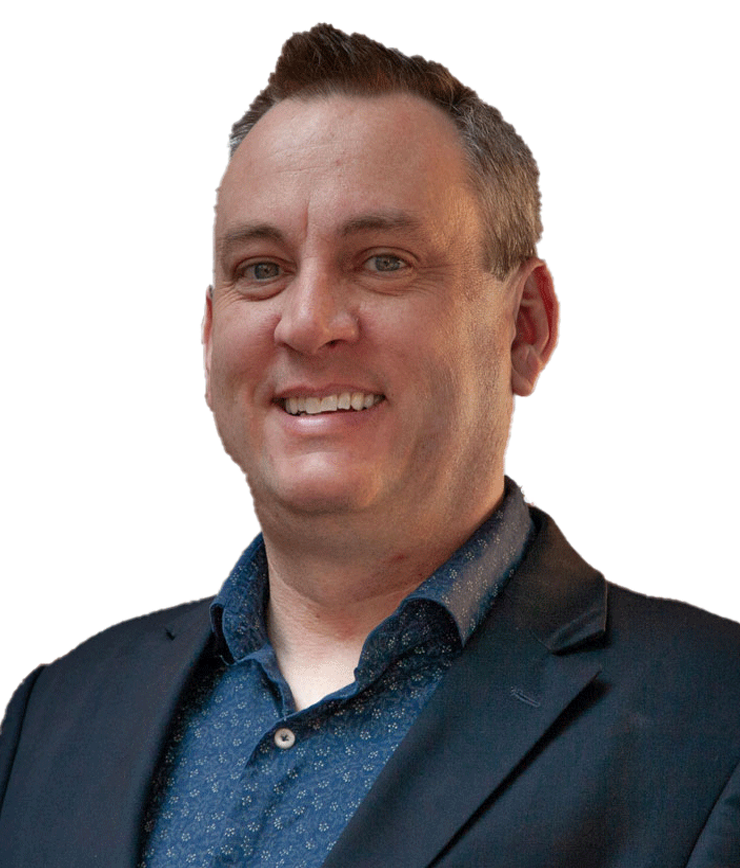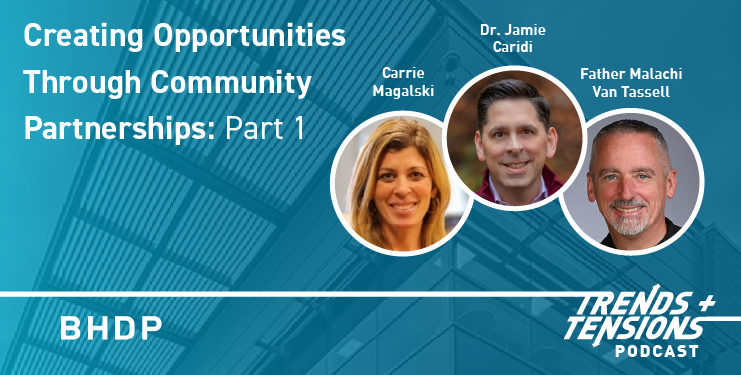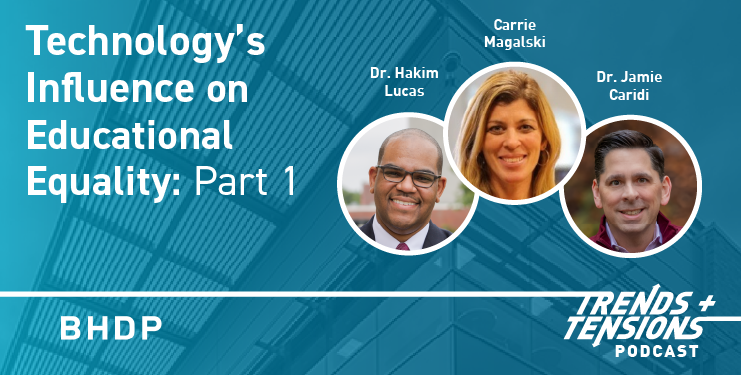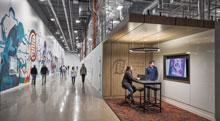
Creating Opportunities Through Community Partnerships: Part 2
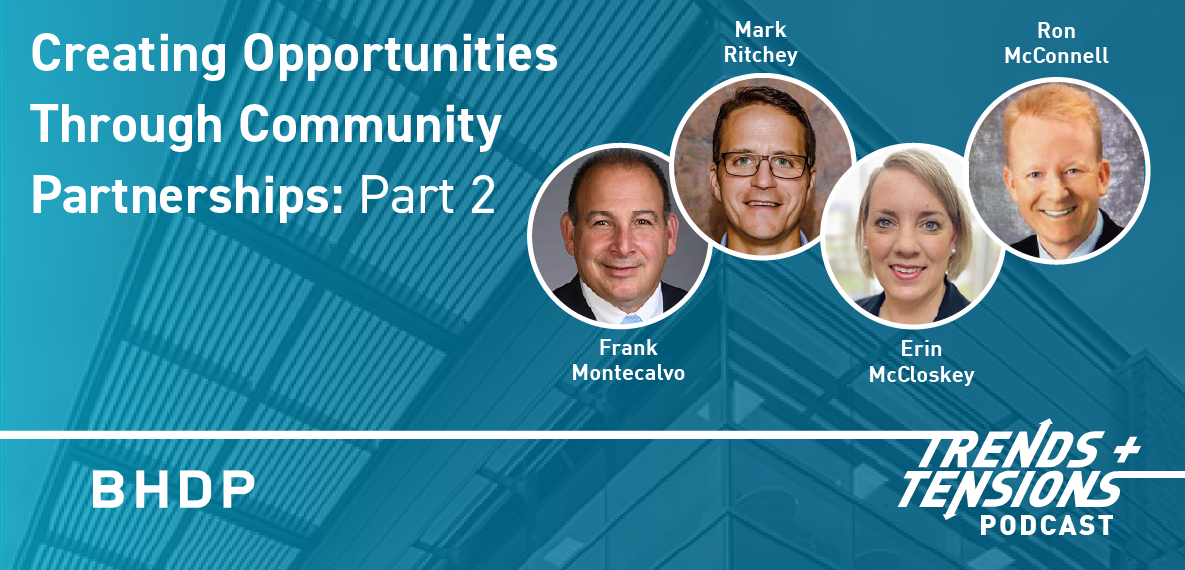
Want to listen on another platform? Choose your platform here.
Episode Transcript
(Music Intro)
Brian Trainer, Host: Welcome to a special edition of Trends + Tensions presented by BHDP, where we discuss trends in architectural and interior design and the competing priorities or tensions that arise from integrating new ideas into existing organizations, enterprises, and institutions. This episode is part of the Higher Education Strategic Partnership series. In this episode, “Creating Opportunities Through Community Partners Part Two,” special guest hosts Dr. Jamie Caridi, President of Terra Firma, and Carrie Magalski, Director of Client Services for Terra Firma, chat with Saint Francis's Erin McCloskey, VP of University Communications and Marketing, and Dr. Frank Montecalvo, VP of Innovative Partnerships and Student Development, as well as Mark Ritchey, President of Curry Rail Services and Principal Partner Curry Supply, and Ron McConnell, representative of the Curry Company, about the strategic partnership the Curry Family of Businesses, has created with Saint Francis University that resulted in the Curry Innovation Center in downtown Altoona, PA. I'm your host, Brian Trainer, Senior Strategist for BHDP. Let's get started.
Carrie Magalski: So, as Curry representatives, what were the roles that each of you played in this strategic partnership with Saint Francis University, and what are some of the outcomes that you have seen with the Curry Innovation Center?
Ron McConnell: We started back in 2018, as Mark said, sort of discussing what the Curry corporate headquarters building was going to be and what it was going to look like. And at that time, I had a really good relationship with Frank Montecalvo and Frank and I were very good friends. We started talking about a lot of their strategic needs and some of the things that they wanted to do as a university. And one of them was they wanted to have more of a presence in Altoona versus the town of Loreto, which is where they're located, and they did have a presence in Blaire County or Altoona already through some of the local high schools, but they wanted sort of a freestanding site. And Curry had already had a relationship with Saint Francis in relation to their engineering students and some of their business students, and so we were providing internships for their students and projects for them to work on. Really, what we decided to do was, in a more formal way, put that partnership together. They had a strategic goal of growing their engineering program from a sort of fledgling program into a real well-developed engineering program. And based upon their emphasis, their strategic goals and our strategic goals were very similar in terms of what our needs were for our company and then what their needs were for their university, and so, that's what really developed into the Curry partnership, which, as Mark said, created the innovation lab, which is really a laboratory where their students can work together with our engineers in new product development and then actually go to the floor of the manufacturing sites and actually see the product being fabricated and made. They also have an environmental engineering program. We are very much into the environmental side of our company as well, so that's worked out well. And then we also have some of their business majors working on things like inventory control and reporting and dashboards and things like that on the business side of the world, too. Yeah, that's how it really started, and now that it's evolving into other things now. I think we just fit well together. I mean, it's a good leadership team—Father Malachi and us and Frank and Pete Schoener and Aaron and all those people are just really great people, and so we mesh well together as humans. I think we do well on the business side, too.
Carrie: Can you give me some background on Curry Family of Businesses, especially with the engineering that I saw—that was some great experience that those students were coming out with and having with your engineers. But what is some background on Curry? So we can get a scope of what they are exposed to.
Mark Ritchey: Sure, I'll touch on the history for a couple of minutes, then I'll move right into current day. But we're currently celebrating our 90th year. Well, we thought we were old, and then Saint Francis’s had their 175th anniversary, so we certainly have some work to catch up there. But Curry originated as a feed store, and we serviced the local farming community for 40 plus years, and that was kind of our bread and butter for a long time, and then we naturally progressed into the industrial side of things, in particular manufacturing.
Carrie: We recently had a round table with university presidents—small independent universities—that are in this landscape in higher ed. They're trying to find innovative ways of “How do we enhance enrollment?” and the economy is unprecedented right now. So the idea of strategic partnerships came up with this leadership team, and one of their questions was, “How do you start entering into or start these conversations or talks?” But from what I've seen with—and this is what we're trying to convey in this story—is you set up a business model that really could be replicated by other universities and other businesses of entering into a strategic partnership like this, but would you have any advice on that aspect of it—the business model of it? Did you have skin in the game? Saint Francis said they came in with skin in the game, and then you also had some grants that were with the building with the revitalization. So, talking about it from that aspect, from the business sense, do you have any kind of advice or suggestions from the experience that you've had with this?
Mark: I think we both had an agreement up front that we both have skin in the game, so to speak, and that's the way we looked at it. It's got to benefit both of us. It can't be one-sided. So, with that approach, and Ron mentioned this earlier, and he can chime in more, but I think the best advice I can give is it's that relationship upfront. Like Ron had mentioned, we knew most of the folks prior to entering into the agreement, whether that was just personal or just through community relations. I was so comfortable going into this because we knew all the players, and we just knew what we were getting ourselves into. These are just such great folks, and we can work through anything; any hurdle that comes our way, I'm sure we can work through it. And Ron, you might want to dive in on this one a little bit more because you were more involved than that than I was.
Ron: Well, yeah. I mean, just from a 30,000-foot perspective, I would answer it the exact same way. I mean, I've never felt like any impediment that we've run up against has been an impediment because we just work it out. The relationships are so strong, and we just work through whatever the issue is. So I'd say in terms of replicability, for us, anyway, it started with relationships, and it all continues to be about the relationship. There were some incentives that actually helped Saint Francis over a hurdle. In terms of building out their space and fitting out their space, there's a program in Pennsylvania called the Neighborhood Assistance Program, which is a tax credit program for which Saint Francis was able to get some funding, and it really helped them with the fit-outs of their space, the building out of their actual floors, the equipping of the engineering labs, and things like that. So again, if we run into a hurdle, we just figure it out. It's sort of like real life, right? And so, that's how we did it.
Carrie: That's phenomenal. We talked a little bit about your future, your vision for the future. What is your vision? Do you see any other kind of innovative projects coming out of this for yourselves or Saint Francis or something more in the future?
Mark: We have two large-scale partnerships—one more on a national level that we're looking at into the industrial side, and then another partnership that’s local with Saint Francis. So, as this evolves, we just start thinking more and more about how we can benefit and how we can both thrive off of each other. It’s really a bright future for us and St. Francis together.
Carrie: That's great.
Mark: I think, for other universities—again, when you look at the replicability of this—I think it's a great model for others to look at because it's a very symbiotic relationship between the two organizations. They benefit greatly from our partnership, and we benefit greatly from their partnership, so it's really not one-sided in any way. I think more universities ought to be thinking this way.
Carrie: I agree. I mean, the doors seem to have opened so wide with other potential partnerships and just the growth aspect of it. One of the things that Father Malachi was talking about was even how it's driving enrollment because it's a really cool experience when students are looking at, “What universities can I get my academic experience in?” And it really helps Saint Francis stand out as far as having an experience where there's an outcome.
Ron: One of the things that universities are traditionally known for is not necessarily keeping up pace with the industry in terms of speed. The one thing that we love about Saint Francis is their ability to pivot and do unique things and not be in that traditional, sort of academic mindset model of, “It takes us five years to think about something.” We tend to move very, very fast, and we found Saint Francis willing to move fast with us, which is unique.
Carrie: Absolutely. Okay, so how are you pitching this, selling this, externally to your students, to your families, to the community? And then, going from that perspective, what are your student experiences? Are they incorporating this into their academic program?
Erin McCloskey: Number one, I think that the partnership is fairly new to us, but it's still evolving, so I think there's also room for growth. And I think that is important in selling it to constituents. It is not a facility, I would say, that is one-dimensional. So, we have the ability to meet with a constituent and say, “This is how you fit into the puzzle. This is how you fit into the puzzle.” There's some flexibility in the space, and it's meant to be an innovative, creative space. So, I think the idea is, “How do you sell it to the enrollment people?” That conversation is different than selling it to our own faculty. It certainly is paramount in the enrollment equation. It is a tool that we are taking to our prospects to say, “Here's where you can invert the classroom or invert your learning experience from day one, and this is how we will ensure that you are a successful learner.” It's the classroom, it's a long-term project that you, as a student, will have access to, and it's working with a partner for hands-on research. And all of that package together is going to make you distinctively marketable once you hit the marketplace. So I think what's important is the message and how we've sold it to people really lies in the flexibility of the space. So we're selling it to prospects as here's an opportunity to embed yourself in a learning experience, and by the way, there are some really awesome things happening. Here's how, from a workforce development issue or adult learner, we're going to offer academic programs that are situated to you and your point in life. Are you a returning adult learner? This is how we can deliver that from the Curry Innovation Center. In terms of marketing it, it depends on what that person's looking for, but there's a really interesting mix of things happening in the space. We have four ongoing research projects we started before the space was completed, believe it or not, where a portion of Curry and their practitioners—their individuals who are working in different offices—are leading research projects with a faculty member and a group of students. So, for instance, Curry has a fluid power component, and our business analytics students did a project with them to build an inventory dashboard so that they had a more sophisticated way of understanding what was on the shelf, what they needed, and how much product they're moving through. So, our students built the Power BI dashboard for the Curry innovation fluid power constituent. I mean, it doesn't get any better than that. But I think what's great is we've got a business analytics research project running, we have an environmental engineering project running, we have an engineering manufacturing project running, we have a fermentation chemistry project running, all stemming really from this awesome space in Altoona. It's amazing to me. It's really fulfilling to be able to see how we sort of plug in the space and what happens in the space into each constituent group. And for every single group, it'll be different, to be honest.
Frank Montecalvo: We talk about mentoring right now, and whether it's leadership or higher ed, the mentoring program is so important. Well, before there was mentoring, it was the apprenticeship programs, right? That's how we taught. That was the main reason or the main pedagogy of engagement to ensure learning. So, we're going backward. We're inverting the classroom. We realize that to teach these complex themes, we're going to have apprenticeships—which there are programs that teach practice theory in a way that when a student graduates, they'll have the practical experience, they'll have a great internship with one of our partners, they’ll have a degree, and then they'll have some type of certification that's in their field. I would say what our researchers said: our partners value the credentials in the experience more than the degree. They expect the degree, but for the person to enter the workforce with a credential or a certification in the experience from the apprenticeship program, they make an impact. So, to your point, Carrie, I think Erin can provide the executive summaries of the research and what we've done, but we're not selling a facility. I think we're selling a framework that is applied in a way that aligns with our mission and has a market value with jobs. And one last paradigm—and this is exciting—we now are saying because of the uniqueness of these opportunities, a traditional student who's living in our residence hall may be taking a few full-class credit experiences on campus but may be in a certification program in Curry that's not credit-bearing and may be having an experience on a job site. And then another semester, they may be a full-time student living in our residence hall. So there are different on-ramps and off-ramps as we prepare students to get credentials, get degrees, and move into the world. Before, we were saying you look one way. A full-time student lives on campus or lives in the community; this is your load; you have that internship experience, maybe your junior year, maybe your summer, and we're saying the opposite. You could be exposed to the field your second semester of your freshman year. And to Erin’s point, we believe if you're selling preparatory experience for a job (i.e., college), wouldn't you showcase the enrollment experience with a partner on site and then bring them to the mothership at another step, maybe not the first step? Families want to see an ROI. If I'm spending 50 grand a year, what's it going to do for me after four? We're going to show you the outcomes first. And that does set a baseline of trust. We're saying “x,” so we have to deliver “x” in four years, and that's where the buy-in comes from.
Carrie: How do you see what you are doing in this partnership as a model that maybe can be replicated? You've found one that's working for you, for the community—for your campus community and the community of Altoona.
Frank: If you're going to move into this field and align with industry—I think institutions, particularly tuition-driven institutions of our nature, that are heavily mission-centered—you have to be aware that you are better off doing few things well rather than many things perhaps average. Knowing that we bring something to the field, and that's content expertise. When Curry brings in Ford, Caterpillar, or Cat, and they are showcasing their products, they're showcasing the R&D development that a university of higher learning offers them. So, our expertise in these fields enhances their brand. The partnership truly has to have an ROI that is on both sides of the ledger—on the partner side and on the university side.
Erin: It's so funny because I just wrote down two points on a piece of paper on my desk as Frank was talking, and my two things are to make sure it's an extension of your brand because I think when you establish a partnership, or you bring a partner in, you still have to be authentic to who you are. I think when they come out of your authenticity, any partnership you build, and you stay sort of on brand, on mission, as we have, then success will follow. There are just so many people on so many sides that are seeing positivity out of it, and I think that's a really important thing. It's not just one group we're reaching; it is multiple constituents. That's important to us, and I know it's important to Father Malachi.
Carrie: So, looking into the future—as you talked about a lot of new partnerships, everything's growing and evolving. So do you see any additional partnerships in the pathway that might be using the center that could come in?
Frank: I think we're going to enhance the opportunities in the fields of engineering and health—natural pillars in the community, in light of the stakeholders that we laid out. UPMC Altoona Hospital System certainly is a stakeholder we want to use. The leadership and business community of Blaire County, particularly in light of the resurgence of the area in Altoona that we're in—these are partners that we can pull from. And I don't want to minimize the natural resources of Votech as we look at continuing partnerships because the engineering platform aligned with the manufacturing needs of the area allows us to serve the independent manufacturing groups that populate Blaire County in the Tri-County area that we're in. So we know the fields that we now have to move into, and this is the beauty of being new. Erin’s getting calls regularly to explore opportunities that people see the model working. I have to say how much I have enjoyed building relations, Carrie, with you and Jamie. Thank you because we have learned quite a bit. I think the work you're doing is quite meaningful to our field, so thank you. Thank you.
Carrie: Well, I appreciate your time today
Erin: Absolutely. We're thankful for the opportunity.
Brian: Thank you for joining Trends + Tensions presented by BHDP for this special episode, “Creating Opportunities through Community Partners Part Two,” with contributing hosts Dr. Jamie Caridi and Carrie Magalski, and their guests, Erin McCloskey, Dr. Frank Montecalvo of Saint Francis University, as well as Mark Ritchey and Ron McConnell of the Curry Family of Businesses. If you appreciate what you've heard, please rate, subscribe, and give us a review. I am Brian Trainer, your host, and I hope you'll join us for another episode of Trends + Tensions to see what topics drive design.
Author
Content Type
Podcast
Date
May 24, 2023
Market
Practice
Topic
Innovation
Higher Education Strategic Partnerships

